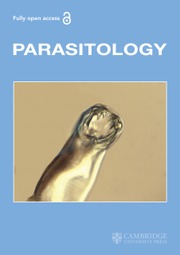No CrossRef data available.
Article contents
Ecto- and endoparasites of the King's skink (Egernia kingii) on Penguin Island
Published online by Cambridge University Press: 19 May 2020
Abstract
Wildlife species are often host to a diversity of parasites, but our knowledge of their diversity and ecology is extremely limited, especially for reptiles. Little is known about the host-parasite ecology of the Australian lizard, the King's skink (Egernia kingii). In spring of 2015, we carried out a field-based study of a population of King's skinks on Penguin Island (Western Australia). We documented five species of parasites, including two ectoparasitic mites (an undescribed laelapid mite and Mesolaelaps australiensis), an undescribed coccidia species, and two nematode species (Pharyngodon tiliquae and Capillaria sp.). The laelapid mite was the most abundant parasite, infesting 46.9% of the 113 captured lizards. This mite species increased in prevalence and abundance over the course of the study. Infection patterns of both mites varied with lizard life-stage; sub-adults were more commonly infested with laelapid mites than adults or juveniles, and sub-adults and adults were infested by more laelapid mites than juveniles. By contrast, adults had a higher prevalence of M. australiensis than juveniles or sub-adults. Among the gastrointestinal parasites, P. tiliquae was relatively common among the sampled lizards (35.3%). These results give new important information about reptiles as parasite hosts and what factors influence infection patterns.
- Type
- Research Article
- Information
- Copyright
- Copyright © The Author(s), 2020. Published by Cambridge University Press



